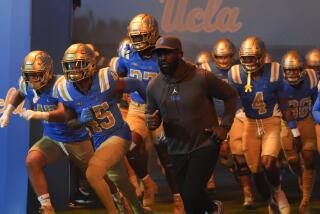Judge Them by Their Cover
- Share via
Come Saturday, the UCLA football team will be facing a tall order.
Heisman Trophy candidate Brady Quinn will be throwing to a big and sure-handed corps of Notre Dame receivers, led by 6-foot-5 Jeff Samardzija, 6-2 Rhema McKnight and 6-6 tight end John Carlson.
The underdog Bruins will counter with 5-9 Trey Brown and 5-11 Rodney Van starting at cornerback, backed by 5-10 freshman Alterraun Verner as the nickel back in passing situations.
An extra-large challenge?
Not really. UCLA pass defenders say they are used to it.
“We’re always going to be challenged because of our size,” Van said. “We play against 6-5 receivers all of the time. We just have to throw that out the window and play football. You’re an athlete who is going up against another athlete.”
What makes stopping Notre Dame’s passing game especially difficult is that Quinn is adept at spreading the ball around, and his receivers are not only tall but top-quality.
McKnight is the team leader with 37 catches for 495 yards and seven touchdowns; Samardzija has 34 for 369 and five; and Carlson has 28 for 397 and two.
Another factor: The quarterback and starting receivers all are seniors.
“With those two guys on the outside, along with the quarterback and tight end, you can see that they’ve played a lot of football together,” said DeWayne Walker, UCLA’s defensive coordinator.
UCLA faced a tall tandem last weekend too, and the Bruins fared relatively well against Oregon’s 6-5 receiving duo of Jaison Williams and Jordan Kent. Williams was held to three catches for 18 yards; Kent was shut out.
“I think our guys do a good job when we put a red dot on a player and signal him out to stop,” Walker said.
However, Oregon’s third option, 6-2 Brian Paysinger, hurt the Bruins with four catches for 105 yards and a touchdown working mostly from a slot position.
That’s the same place Notre Dame’s Carlson likes to work from.
And then there’s Quinn, who’s 6-4 himself, and has completed 148 of 233 passes (63.5%) for 1,634 yards and 16 touchdowns with only four interceptions. He needs 30 yards to reach 10,000 in his college career, and his experience and comfort with the offense have been big factors in the Fighting Irish’s 5-1 start. Notre Dame’s only loss is to Michigan, and the Irish are averaging 30.3 points a game.
“He’s really starting to come into his own this year,” Notre Dame Coach Charlie Weis said of Quinn. “We’ve been able to give him more responsibility and that has allowed us to get out of some bad situations.”
One of Quinn’s strengths is his ability to put passes in areas that only his big receivers can get to -- the operative word there being big. McKnight, who played at La Palma Kennedy High, weighs 208 pounds, Samardzija 216 and Carlson 250. UCLA safety Chris Horton, at 6-2, 210 pounds, will often match up against Carlson.
None of the Notre Dame trio has blazing speed but, as UCLA’s Walker noted, they “know how to position themselves to make catches. Smaller corners should be concerned with big receivers. You can have great coverage and they can still complete passes.”
Statistically, UCLA (4-2) has the second-best pass defense in the Pacific 10 Conference, behind only Oregon. The Bruins give up an average of 167.7 yards a game, with only two teams having passed for more than 200 yards.
Brown, a junior three-year starter, is considered the Bruins’ top coverage defender. He is tied with Verner and Horton for the team lead in interceptions with two, and he leads in passes broken up with six.
“He’s a great football player who has been an emotional leader for us,” linebacker Christian Taylor said. “Trey plays with a lot of heart and is a very smart player. Even if a guy is bigger and faster than him, he still beats them.”
At the very least, UCLA will come into the game with some experience going up against high-powered passing attacks. Such is life in the Pac-10, which features some of college football’s best passers.
“Their size will play a factor in the game because that leaves them open for jump ball plays and a lot of fades in the red zone,” Van said. “But ... I have to cover them regardless, whether they are 6-5, 6-2 or 5-11. It really doesn’t matter.”
More to Read
Go beyond the scoreboard
Get the latest on L.A.'s teams in the daily Sports Report newsletter.
You may occasionally receive promotional content from the Los Angeles Times.






